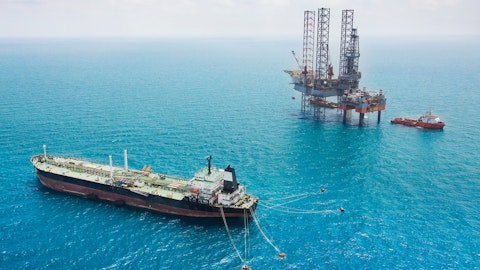But we certainly are going to see, I think, competition for Haynesville supplies that have traditionally come in, a lot of that’s come into Station 85 and that will certainly be in competition with 165 for a while. And that’ll really dictate which way the volumes flow on there. But as those big LNG – and the LNG capacity growth is not all that hard to predict. The projects are out there and they’re hard to sneak up on anybody just because they’re so big and take so long for permitting. So that LNG market is becoming very evident and it will certainly take away supplies that a lot of the Transco customers have depended on coming in Station 85. And I do think to your point, I do think that’s why we’re seeing such an interest in picking up supplies off of Mountain Valley Pipeline.
But I also tell you that largely just because the markets are growing in those areas is really what’s driving that as they really start to run out of options for meeting power generation loads in those areas.
Michael Dunn: And Alan, probably important to note this is not a near-term macro. This macro setup is going to be over the next decade and beyond as LNG demand increases and power demand on the eastern side of the United States continues to change. There’s going to continue to be a competition between utilities and LNG exporters for natural gas, and there is no better asset set up to benefit from that and provide the supplies that are needed than our footprint in the Transco system.
Neel Mitra: Great. And then my follow up, your Texas to Louisiana Energy Pathway Project, I think it’s roughly $364 million a day in 2025. And it seems like crossing the border between Texas and Louisiana is actually harder than we initially expected. What are the opportunities for you to be able to move Transco volumes from South Texas, whether they’re sourced from the Permian or Eagle Ford up to the Louisiana Energy Corridor with compression or even looping in what are kind of the impediments towards scaling up the size of Transco to be able to do that?
Michael Dunn: Hey Neel, it’s Michael. Thanks for the question. Yes, the TLEP project is just awaiting at 7C [ph] permit. So we would expect that to be imminent. So we’re excited to get that one off the ground. And that’s really the first opportunity we’ve had to really increase our capacity from the South Texas area into the LNG corridor order on the other side of Houston. I would just tell you, we’ve got a lot of great opportunities to continue to expand that pathway on Transco. We have a lot of looping capabilities through that area, additional compression that we can add and really move a significant amount of gas to either South Texas or the Katy area over to that Texas, Louisiana coast line where the LNG facilities are being contemplated for expansion.
So really excited about those opportunities. We are talking to parties on both sides of that, whether it be a producer or a consumer of the gas on both sides of that opportunity. And the biggest impediment there is Houston, as you probably well know that the Transco pipeline system to reverse is just north of Houston there in that corridor, and we have one of the best quarters, we think, to expand from the west side of the Houston area over to the eastern LNG corridor.
Neel Mitra: Got it. And just to follow up on that answer, what’s the FERC lag in terms of approving a loop. I know compression is much easier. I think that’s what you did with Texas to Louisiana pathway. But how much harder would it be to get the regulatory filing for a loop on Transco once you make that compression on that front?
Michael Dunn: Yes. So right now, FERC has lowered their hurdle, I would say, for smaller projects like TLEP. So it was originally an environmental assessment and FERC basically came back and said, “No, we need any EIS and then they pivoted back and said, “No, this can go under an environmental assessment, which is a quicker process. You probably save six months to nine months on the environmental review typically between an EIS and an EA. And I would say any looping project of any magnitude is most likely going to take an environmental impact statement. And so that’s – whether it be a looping or a greenfield, it’s going to be an EIS, and that process is typically one and a half year to two years from filing to 7C approval.
So I would just say that’s the kind of the time line you should be thinking about for any type of looping project. I would say the looping projects are less controversial when you start talking to the environmental organizations and landowners just because we’ve obviously been in the area for a long time. We have relationships built in those areas and landowners are certainly much more receptive to a looping project than they are a greenfield type pipeline. And certainly, the environmental impact is less as well. And so I think you do have a better opportunity to get approvals for looping project because they’re just less controversial and FERC is very interested in condemnation authority in the use of that these days and it gives us a great benefit when we’re looking at looping projects just like our [indiscernible] project, we built 36 miles of loop along that pipeline and did not have one condemnation with several hundred landowners and it’s a great testament to what the brownfield expansion is going to do for our company.
Neel Mitra: Great. Thank you very much.
Operator: Thank you. We’ll go next now to Theresa Chen at Barclays.
Theresa Chen: Good morning and thank you for taking my question. First, on the DJ acquisitions, if 7x is stand-alone, how low do you think you can bring that in multiple with the downstream synergies? And are there additional opportunity for and portfolio optimization going forward?
Chad Zamarin: Yes. Thanks, Theresa. This is Chad. I won’t speak specifically, but we are typically looking for leveraging our footprint and our strategic positioning where we operate. We’ve been focused on bolt-on transactions that typically provide better than one or two turns of synergies and optimization. This is an integration that allows us to both increase gathering, processing, also we moved the NGLs down Overland Pass with our partnership with Targa, we can move the barrels all the way to Mont Belvieu, where we have interest fractionation. And so there’s a lot of opportunity to capture synergies along that value chain. So those are the kind of opportunities that we really look for that, provide very clear commercial and operational synergies.




